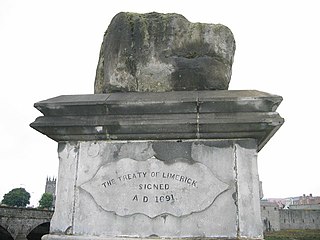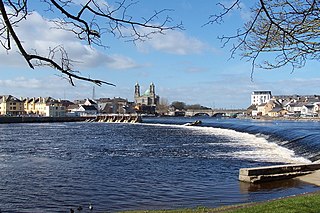
The Battle of the Boyne took place in 1690 between the forces of the deposed King James II, and those of King William III who, with his wife Queen Mary II, had acceded to the Crowns of England and Scotland in 1689. The battle was fought across the River Boyne close to the town of Drogheda in the Kingdom of Ireland, modern-day Republic of Ireland, and resulted in a victory for William. This turned the tide in James's failed attempt to regain the British crown and ultimately aided in ensuring the continued Protestant ascendancy in Ireland.

James FitzJames, 1st Duke of Berwick, 1st Duke of Liria and Jérica, 1st Duke of Fitz-James was an Anglo-French military leader and the illegitimate son of King James II and VII by Arabella Churchill, sister of the 1st Duke of Marlborough. Berwick was a successful general in the pay of Louis XIV of France.

Field Marshal George Hamilton, 1st Earl of Orkney,, styled Lord George Hamilton from 1666 to 1696, was a British soldier and Scottish nobleman and the first British Army officer to be promoted to the rank of field marshal. After commanding a regiment for the cause of William of Orange during the Williamite War in Ireland, he commanded a regiment in the Low Countries during the Nine Years' War. He then led the final assault at the Battle of Blenheim attacking the village churchyard with eight battalions of men and then receiving the surrender of its French defenders during the War of the Spanish Succession. He also led the charge of fifteen infantry battalions in an extremely bloody assault on the French entrenchments at the Battle of Malplaquet. In later life, he became a Lord of the Bedchamber to George I and was installed as Governor of Edinburgh Castle.

Henry FitzRoy, 1st Duke of Grafton, was an illegitimate son of King Charles II of England and his mistress Barbara Villiers. A military commander, Henry FitzRoy was appointed colonel of the Grenadier Guards in 1681 and Vice-Admiral of England from 1682 to 1689. He was killed in the storming of Cork during the Williamite–Jacobite War in 1690.

The Treaty of Limerick, signed on 3 October 1691, ended the 1689 to 1691 Williamite War in Ireland, a conflict related to the 1688 to 1697 Nine Years' War. It consisted of two separate agreements, one with military terms of surrender, signed by commanders of a French expeditionary force and Irish Jacobites loyal to the exiled James II. Baron de Ginkell, leader of government forces in Ireland, signed on behalf of William III and his wife Mary II. It allowed Jacobite units to be transported to France, the diaspora known as the Flight of the Wild Geese.

The Williamite War in Ireland took place from March 1689 to October 1691. Fought between supporters of James II and his successor, William III, it resulted in a Williamite victory. It is generally viewed as a related conflict of the 1688 to 1697 Nine Years' War.

The Battle of Aughrim was the decisive battle of the Williamite War in Ireland. It was fought between the largely Irish Jacobite army loyal to James II and the forces of William III on 12 July 1691, near the village of Aughrim, County Galway.

Godard van Reede, 1st Earl of Athlone, Baron van Reede, Lord of Ginkel, born in the Netherlands as Baron Godard van Reede, was a Dutch general who rose to prominence during the Williamite War in Ireland.

Charles Fort is a trace italienne fortification, a bastion fort with one section of the outer wall built in star fashion. It is located at the southern end of the village of Summer Cove, on Kinsale harbour, County Cork, Ireland. First completed in 1682, Charles Fort was sometimes historically referred to as the "new fort" - to contrast with James' Fort which had been built on the other side of Kinsale harbour before 1607. The fort is now operated as a heritage tourism site by the Heritage Ireland arm of the Office of Public Works.

Athlone was besieged twice during the Williamite War in Ireland (1689–91). The town is situated in the centre of Ireland on the River Shannon and commanded the bridge crossing the river into the Jacobite-held province of Connacht. For this reason, it was of key strategic importance.

Limerick, a city in western Ireland, was besieged twice in the Williamite War in Ireland in 1689–1691. On the first occasion, in August to September 1690, its Jacobite defenders retreated to the city after their defeat at the Battle of the Boyne. The Williamites, under William III, tried to take Limerick by storm but were driven off and had to retire into their winter quarters.

The siege of Limerick in western Ireland was a second siege of the town during the Williamite War in Ireland (1689–1691). The city, held by Jacobite forces, was able to beat off a Williamite assault in 1690. However, after a second siege in August–October 1691, it surrendered on favourable terms.

Ballymore is a village in County Westmeath, Ireland, on the R390 road between Athlone and Mullingar. The historic Hill of Uisneach is nearby. The village was known in medieval times as the medieval borough of Ballymore Lough Sewdy, or Loughsewdy, after the nearby lake, the site of an ancient bruighean, or hostel.
Events from the year 1690 in Ireland.
John Barrett was a colonel and head of the barony of the Cork Barrett family.

The siege of Athlone was part of the Williamite War in Ireland between the supporters of King James II, who were known as Jacobites, and the supporters of King William of Orange. The siege began on 17 July 1690, when Williamite Lieutenant-General James Douglas arrived outside the Jacobite held city of Athlone with ten regiments of foot and five regiments of horse for a total force of 12,000. The Governor of Athlone, Colonel Richard Grace decided to defend the western part of the city. The Jacobite troops destroyed the bridge over the Shannon River that connected the eastern and western parts of the city, before the Williamite Army arrived. The city's garrison consisted of three regiments of foot and eleven troops of horse for a total force of about 4,500.

The siege of Carrickfergus took place in August 1689 when a force of Williamite troops under Marshal Schomberg landed and laid siege to the Jacobite garrison of Carrickfergus in Ireland. After a week the Jacobites surrendered, and were allowed to march out with the honours of war.
The Capture of Bandon occurred in 1689 when the town of Bandon in County Cork, Ireland was forcibly seized from its rebellious Protestant inhabitants by a force of Irish Army troops under Justin McCarthy. The skirmishing at the town took place during the early stages of the Williamite War in Ireland. The Jacobite success at Bandon helped suppress any chance of a general Munster uprising against the rule of James II similar to that which occurred in Ulster the same year. The slogan "No Surrender!" is believed to have been first used at Bandon and subsequently taken up, more famously, by the defenders at the Siege of Derry the same year.

The Capture of Waterford took place in July 1690 during the Williamite War in Ireland when a force under the command of Percy Kirke captured the town of Waterford from its Jacobite Irish Army garrison. Full control of the town was not secured until Duncannon Fort across Waterford Harbour was also taken from its garrison under Michael Burke shortly afterwards. In both cases the garrisons were allowed to march out under escort to Jacobite-held Mallow in County Cork, but were denied the "honours of war" which they demanded.

The Danish Auxiliary Corps was a corps of 7,000 Danish soldiers sent to fight with William of Orange who was at war in Ireland. Disappointed with his alliance with France's King Louis XIV, Christian V of Denmark–Norway in 1689 entered into a treaty of military assistance with King William III of England. The corps was transported to Ireland, fighting against the Jacobites, participating in the battles of the Boyne and Aughrim, as well as the sieges of Limerick, Cork, Kinsale, Athlone, and Galway. In early 1692 the corps was transported to Flanders for future service in English pay.


















